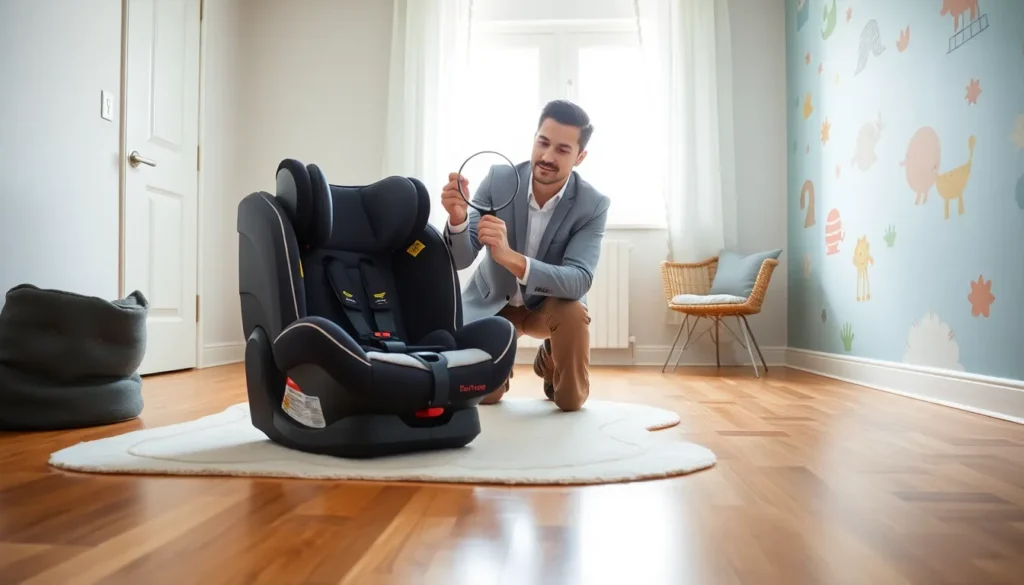Have you ever looked at your car seat and wondered if it’s still safe? Like a fine wine, car seats do have an expiration date, but luckily, you don’t need to check for casks or labels. In today’s guide, we’re diving into the world of car seat expiration dates. It’s a thrifty, safety-focused journey every parent should embark on, and yes, a sprinkle of humor never hurt anyone. Buckle up, because we’re about to make this topic both enlightening and a little entertaining.
Table of Contents
ToggleUnderstanding Car Seat Expiration Dates

Car seats, while designed to keep precious cargo safe, have a shelf life. Many parents might be unaware that car seats all come with an expiration date, usually ranging from six to ten years after the manufacturing date. Why? Over time, materials can degrade due to exposure to various environmental factors. UV rays from the sun, humidity, and even simply the passage of time can weaken the structural integrity of the seat. Understanding this expiration date ensures that when something amazing happens, like your child suddenly growing taller than you–their car seat is ready to handle the ride. Remember, it’s not about making a fashion statement, it’s about keeping everyone safe.
Why Car Seats Have Expiration Dates
Every car seat you see on store shelves has a carefully calculated expiration date, and there’s a good reason for that. Manufacturers set these dates based on extensive safety testing. The plastic components can become brittle over time due to factors like temperature fluctuations and exposure to sunlight. Also, the technology behind safety standards evolves. While a seat may have been the cream of the crop five years ago, new innovations mean today’s seats may offer better protection. Just think of it this way: if your tech gadgets can’t survive longer than a few years, why should a car seat? It’s designed to protect your most valuable passengers, so it’s crucial to avoid relying on outdated equipment.
Where To Locate The Expiration Date
Finding the expiration date on a car seat isn’t an Olympic event, but it can feel a little like a scavenger hunt. Manufacturers usually put the date on a sticker or tag affixed to the base of the car seat. This location varies by brand, so be prepared to check a few spots. Look for a label that contains information about the manufacture date: the expiration date is often included right there. If you’re struggling, check the user manual: it may provide specific details on where to find it. In some cases, you might need a magnifying glass and a great sense of humor because, let’s face it, those labels can be small. If you’re still blanking, visiting the manufacturer’s website can be a treasure trove of information.
Interpreting The Manufacturing Date
Okay, so you’ve found the manufacturing date, awesome. Now what? The expiration date generally follows a straightforward rule: it’s often six to ten years after the manufacturing date, but you’ll need to check your specific car seat instructions for the precise details. If the manufacturing date reads 2018, for instance, and the expiration is set for 2024, it’s a good idea to keep a reminder in your phone. That way, when the date approaches, you can shop for a new seat while giving yourself a little pat on the back for being proactive. Remember, dates are significant, and your little one’s safety is paramount.
Common Myths About Car Seat Expiration
Car seat safety is riddled with myths, and it’s time to bust a few. One of the most common misunderstandings is that car seats are safe as long as they still look good. Spoiler alert: looks don’t equate to safety. Another frequent myth claims that second-hand car seats are just fine if they don’t appear damaged. Friends, while it’s tempting to snag a bargain from Grandma’s attic, be cautious. You might not know the history of the seat, including previous accidents. Also, many believe that storing a car seat in your garage is safe. Unfortunately, fluctuating temperatures can jeopardize its safety. Keep these myths in mind when you’re navigating the often puzzling world of car seat safety.
Best Practices For Car Seat Safety
Keeping your child safe in a car seat goes beyond just knowing its expiration date. Here are some best practices to consider:
###1. Always rear-face as long as possible
Experts recommend keeping children in rear-facing seats until they reach the maximum height or weight limits established by the seats’ specifications. This provides the most protection during a crash, as their small bodies can tolerate it better.
###2. Securely install the seat
Ensure that the seat is installed correctly. Many car seats come with guides to help, so don’t be afraid to consult the manual. A wobbly seat is not a safe seat.
###3. Check the harness
Ensure the harness is snug. There should be no more than one finger’s gap between the harness and your child’s collarbone. Make sure your little astronaut is secure.
###4. Seek professional help if needed
If you’re unsure about the installation, local fire stations or hospitals often offer car seat inspections, which is a great service that provides peace of mind.










